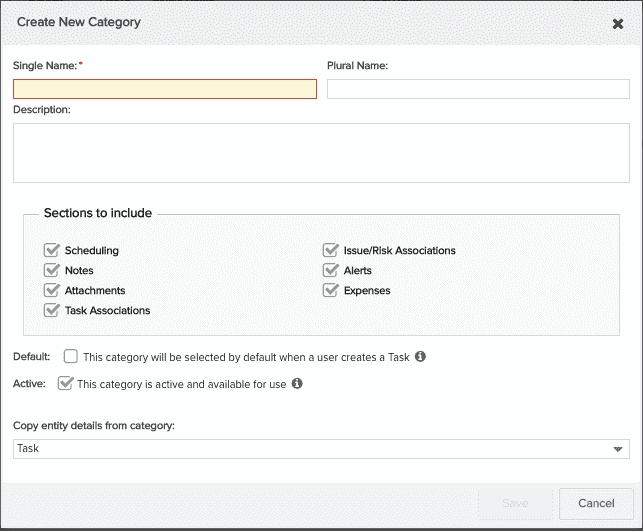Creating Categories for Tasks
Categories are types, or variations, of an entity (task, issue, portfolio, asset and so on). You use categories if you need to have different versions of an entity. Different categories can have different set of fields displayed on the entity's Detail panel, as well as different set of component tabs such as Notes, Attachments, Alerts, and Team.
If there is only one category, it will be used by default when you configure the Details panel (you won't have to select it), and the end user will never see any mention of a category on the entity grid since there will be only one entity "type". Also note that the Category property will not appear in the entity Details. If you have multiple categories, you will need to configure a Details page for each category to define its associated Details panel; as a result, the end-user will be able to create entities from each category "type," provided the categories are active.
Note: Fields will retain their data even if you convert an instance of an entity to a category that does not include that field. For example, if the Priority field is shown on the Details section for Category A but not for Category B, the Priority field will show data for all reports, regardless of the entity's current category. Data always stays with the field.
Also regarding changing categories: end users should note that changing categories mid-flight will not change the form until after they save. This can result in the display of some required fields that have no data, because those required fields were not part of form displayed by the initial category. For example, if the user selects the Defects category and then changes the Category to Enhancement Requests and saves, any required fields unique to the Enhancement Request category will be empty because they did not appear on the Defects form. Typically you cannot get into a state where required fields are empty once a form is saves (saving prevented until required values are entered). The next time you edit the form you will be required to enter values for the required fields before you can save.
To create a task category
- From All Entities/Setup/Tasks/Categories, choose New > New Category.
- Fill out the relevant properties in the New Category dialog as described below:

|
Field |
Description |
|---|---|
|
Single Name |
(Required) The name of the category. Appears in the Category droplist when laying out details. If you have multiple categories, you can create different Details layouts for each. |
|
Plural Name |
Plural name of the category. |
|
Description |
Informational text that will appear in the Category field's Description property. |
|
Sections to include |
Select the checkbox next to the tabs you wish to appear for tasks of this category type. Note: If you plan to create associations between tasks and other entities, such as project logs or financial entries, the entities on both ends of the association need to have the respective <Entity> Association section included in their category. For example, if you plan to associate Tasks with Project Logs, then the task category must include the Project Log Associations section, and the Project Log category must include the Task Associations section. |
|
Default |
Indicates whether this category is the default. The default category will be selected automatically when the user creates a task. There must be one default category. If you configure a default category and then make a new category the default, the original category will no longer have this property enabled. You cannot "turn off" the Default property in a category - you must instead designate a different category as the default. Note that the default category must be active. You can override the default on a project-by-project basis by adding the Default Task Category field to the project Details tab. |
|
Active |
Select the Active checkbox to make the category available to the Admin in the Category dropdown when configuring task Details, and to the end user when creating a task. Categories are active by default. Deselect the checkbox to hide the category (will not appear in the New Task options when the user creates an instance of the entity, or in the Categories droplist when the admin is configuring Details). |
|
Copy entity details from category |
Every category has a corresponding set of fields that you provide to the end user on the task's Details tab. If you are creating a category that reuses fields (details) from an existing category, you can copy those details into the new category to use as a starting point. Select the name of the category from the droplist, or use None to indicate not to copy details. If you elect not to copy details, the new category will have a default set of fields. |
- Click Save.
Editing a Category
You can edit a Category by double-clicking it or selecting it and choosing Actions > Edit. The resulting modal is similar to the one above, without the option to "Copy entity details from category".
You can modify a category at any time. The end user will not see the changes until the screen is refreshed. For example, you can add fields to a project Details section, but the end user won't see the new fields until they refresh the browser window. If the end user is on a different page when the change happens, they will see the fields when they navigate back to the Details section.
Copying a Category
You can copy a Category by double-clicking it or selecting it and choosing New > Copy.... The resulting dialog is similar to the one above, without the option to "Copy entity details from category". The resulting modal is similar to the one above, except that the "Copy entity details from category” option is set to the selected category.

